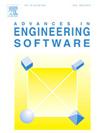A simple and efficient mesh cutting algorithm and software library based on many-to-many relations
IF 4
2区 工程技术
Q2 COMPUTER SCIENCE, INTERDISCIPLINARY APPLICATIONS
引用次数: 0
Abstract
In this paper, we introduce a new open-source self-contained software library to carry out edge cut based remeshing on a simplicial 3-complex. The result is very concise, highly performant (more than tetrahedra are cut in less than one minute) and can be used for most remeshing tasks. Tasks performed by the algorithm are (i) mesh carving by means of implicit surfaces, (ii) mesh cutting to form a crack and (iii) mesh cutting/carving by a facet mesh and (iv) adaptive remeshing. Source code for algorithms and examples is made available. In the context of a framework based on generalized elements, where all boundary conditions, constraints and traditional finite elements are treated as one, adaptive capabilities are essential in such a framework. This paper presents a lightweight and robust approach to solve a classical problem. Technical intricacies related to robust remeshing (coarsening and refining) can be especially daunting and are here decoupled from the mesh operations. Extraneous themes to be addressed are the mapping of essential and natural conditions, degrees-of-freedom at nodes and internal to the elements, mapping of history variables, etc. We therefore propose and describe in detail a new approach, which is both general and flexible. Six verification examples are presented, that illustrate the use of the library. In addition, a worked example describing the library usage is presented.
求助全文
约1分钟内获得全文
求助全文
来源期刊

Advances in Engineering Software
工程技术-计算机:跨学科应用
CiteScore
7.70
自引率
4.20%
发文量
169
审稿时长
37 days
期刊介绍:
The objective of this journal is to communicate recent and projected advances in computer-based engineering techniques. The fields covered include mechanical, aerospace, civil and environmental engineering, with an emphasis on research and development leading to practical problem-solving.
The scope of the journal includes:
• Innovative computational strategies and numerical algorithms for large-scale engineering problems
• Analysis and simulation techniques and systems
• Model and mesh generation
• Control of the accuracy, stability and efficiency of computational process
• Exploitation of new computing environments (eg distributed hetergeneous and collaborative computing)
• Advanced visualization techniques, virtual environments and prototyping
• Applications of AI, knowledge-based systems, computational intelligence, including fuzzy logic, neural networks and evolutionary computations
• Application of object-oriented technology to engineering problems
• Intelligent human computer interfaces
• Design automation, multidisciplinary design and optimization
• CAD, CAE and integrated process and product development systems
• Quality and reliability.
 求助内容:
求助内容: 应助结果提醒方式:
应助结果提醒方式:


